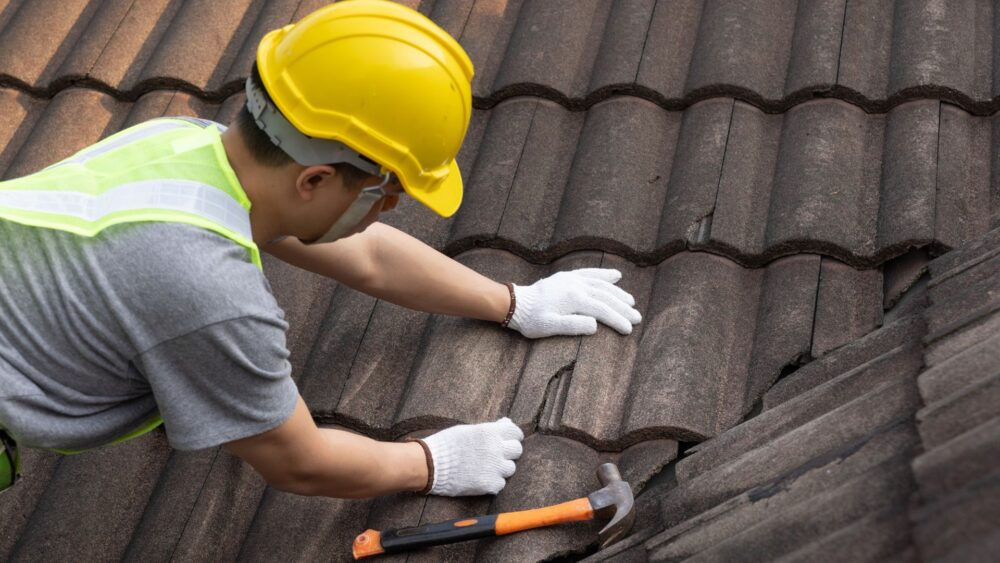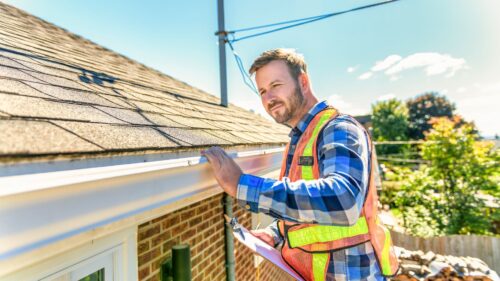Ever wondered why some houses in your neighborhood always look impeccable, no matter the season? Well, spoiler alert: it’s not just about the paint or garden. A big part of that curb appeal is due to diligent roofing maintenance. Whether you’re an independent homeowner or looking after a property for someone else, understanding the ins and outs of roofing maintenance can save you from headaches and hefty bills down the line.
So, this guide isn’t just about dodging bullets; it’s more like laying down the groundwork today for a smoother ride tomorrow. So yes, while we all might grumble about checking gutters or inspecting shingles on a sunny Saturday afternoon, these small acts are what keep our homes safe, sound, and stunning.
Essential Steps for Roofing Maintenance
Your roof is your home’s first line of defense against the elements. But it can only do its job if you give it some TLC. Neglecting roof maintenance is a surefire way to end up with costly repairs down the line.
The good news? Basic roof maintenance isn’t rocket science. Knocking out a few easy tasks can make all the difference in keeping your roof in tip-top shape and steering clear of any damage. Here are the essential steps every homeowner should know.
Routine Gutter Cleaning
Clogged gutters are a roof’s worst enemy. When debris builds up, it prevents proper drainage and can cause water to pool on your roof. As time marches on, these little problems can snowball into leaks, decay, and a bunch of other headaches you really don’t want to deal with.
The fix? Clean your gutters at least twice a year, or more if you have a lot of trees near your home. Someone’s got to roll up their sleeves and tackle the messy tasks, right? Or you could always hire a pro to handle the task for you.
Regular Trimming of Nearby Trees
Overhanging tree branches can scratch and damage your roof’s surface. At the same time, these branches roll out the welcome mat for critters like squirrels and raccoons, giving them a VIP pass straight to your roof where they’re free to stir up all kinds of trouble.
To prevent this, trim any branches that are getting too close to your roof. A good rule of thumb is to keep them at least 10 feet away. If you’re not comfortable wielding a chainsaw, call in a tree trimming service.
Periodic Debris Removal from the Roof
Over time, your roof might start collecting a mix of leaves, twigs, and other bits and pieces that the wind or birds drop off. If left unchecked, this debris can trap moisture against your roof’s surface, leading to rot and deterioration.
To keep your roof in tip-top shape, remove debris on a regular basis. A leaf blower or soft-bristled broom can do the trick. Just be careful not to damage any shingles in the process. And remember, when you’re up there tackling your roofing projects, putting safety first is a must.
Identifying Signs of Roof Damage
Even if you’re on top of things and give your roof the TLC it deserves, time can still throw a curveball, leading to wear and tear. Nipping issues in the bud before they blow up into massive headaches is really what it’s all about. Here’s what to look out for.
Spotting Interior Damage Indicators
Sometimes, the first signs of roof damage show up inside your home. Always be on the lookout for those telltale water stains on your ceilings or walls, particularly in the attic. Peeling paint or wallpaper can also be a red flag.
So, if any of these red flags pop up, it’s definitely worth digging a little deeper. A professional roof inspection can help pinpoint the source of the problem.
Inspecting for Damaged or Missing Shingles
Your roof’s shingles are its first line of defense against the elements. Over time, they can become cracked, curled, or even go missing altogether. So, if you’re not careful, your roof might just start letting in water and picking up other kinds of damage.
To catch shingle issues before they spiral out of control, perform a visual inspection of your roof from the ground. Grab your binoculars for a closer peek, and stay sharp for any hints of wear or damage. If you spot any damaged or missing shingles, call in a pro to assess the situation.
Checking Fascia and Soffits for Water Damage
Your roof’s fascia and soffits play a crucial role in ventilation and water drainage. When they start to fall apart or rot sets in, you’re opening the door wide for some nasty surprises like mold popping up everywhere and unwanted critters deciding to move in.
During your regular roof inspections, take a close look at your fascia and soffits. Watch out for clues that water’s been up to no good, like spots changing color, floors or walls starting to bow, or ceilings taking a dive. If you notice any issues, address them ASAP to prevent further damage.
Addressing Moss and Mold on Your Roof
Moss and mold aren’t just unsightly – they can also wreak havoc on your roof. Left unchecked, these pesky growths can trap moisture against your roof’s surface, leading to rot and deterioration. So, let’s dive into how you can keep those nuisances away.
Removing Moss & Mold from Your Roof
If you notice moss or mold starting to take hold on your roof, it’s time to take action. Luckily, with a bit of effort and some good old-fashioned elbow grease, you can often tackle these growths yourself.
Start by mixing equal parts water and bleach in a spray bottle. Then, apply the solution to the affected areas and let it sit for 15-20 minutes. Use a soft-bristled brush to scrub away the moss and mold, being careful not to damage your shingles in the process. Rinse the area thoroughly with a garden hose when you’re done.
Annual Treatment for Moss, Lichen, and Algae
Prevention is key when it comes to keeping moss, lichen, and algae at bay. One effective strategy is to apply an annual treatment to your roof.
Look for a product specifically designed for removing moss and algae from roofs. These treatments are packed with potassium salts from fatty acids, which play a big role in stopping new growth dead in its tracks. Apply the treatment according to the manufacturer’s instructions, and be sure to reapply annually for best results.
The Role of Regular Inspections in Roofing Maintenance
Regular inspections are the backbone of any good roof maintenance routine. Nipping problems in the bud means you can often stop them from blowing up into bigger headaches later on. Here’s what you need to know.
Seasonal Shingle Inspection
Your roof’s shingles take a beating throughout the year, from harsh UV rays in the summer to frigid temperatures in the winter. So, it’s super crucial to give them a once-over now and then for any signs that they’ve been through the wringer.
At least once per season, take a close look at your shingles from the ground using binoculars. Watch out for any signs of wear like cracked, curled, or missing pieces on your shingles. If you spot any issues, call in a pro to assess the damage and recommend repairs.
Importance of Regular Roof Inspections
In addition to seasonal shingle inspections, it’s a good idea to have your roof professionally inspected at least once per year. A trained eye can spot issues that you might miss, such as small leaks or areas of weakness.
During an inspection, your roofer will check for signs of damage, assess the overall condition of your roof, and recommend any necessary repairs or maintenance tasks. Think of it like a yearly checkup for your roof – it’s an investment in the long-term health of your home.
Professional Roofing Maintenance and Repair
While there are plenty of roof maintenance tasks you can handle yourself, some jobs are best left to the pros. Here’s when to call in reinforcements.
When to Hire a Professional Roofer
If you spot signs of damage on your roof, such as missing shingles or leaks, it’s time to call in a professional. Attempting repairs yourself can often do more harm than good, especially if you’re not experienced in roofing work.
Other times to hire a pro include after a major storm or if your roof is nearing the end of its lifespan. When you’ve got a pro roofer taking a look, they can quickly figure out how bad the damage is and let you know whether some repairs will do the trick or if it’s time to go all in on a new roof.
Choosing a Trusted Roofing Contractor
Not all roofing contractors are created equal. To make sure you’re getting top-notch service, rolling up your sleeves and doing a bit of research before hiring anyone is pretty much a no-brainer.
Start by looking for a contractor with plenty of experience and a solid reputation in your area. Digging into online reviews and reaching out for feedback from previous clients can really open your eyes to what you’re getting into. Always check that they have a license and insurance, and don’t hesitate to ask them to show you the paperwork. Finally, get everything in writing before work begins, including a detailed estimate and timeline for the project.
Roofing Maintenance FAQs:
What maintenance should be done on a roof?
Clean gutters, trim tree branches, remove debris, and check for damage regularly. It’s also important to tackle moss and mold head-on.
How often should I maintain my roof?
You should aim for twice a year—spring and fall are the best times to catch issues early and prepare for extreme weather.
Do shingle roofs need maintenance?
Absolutely. Keep an eye out for cracked or missing shingles and get them fixed promptly to avoid leaks.
How do you maintain a roof at home?
Sweep off leaves, unclog the gutters, and inspect the roof after storms. Simple steps like these can save you a significant amount of money down the line.
Conclusion
In wrapping up this rooftop journey together – because let’s face it if there was ever an unsung hero in our home stories, it’s got to be our roofs – remember that regular roofing maintenance doesn’t have to be a drag. It’s really about keeping those silent guardians above us happy so they can continue doing their job without fuss. Find a contractor today and get free quotes by filling out this form.



